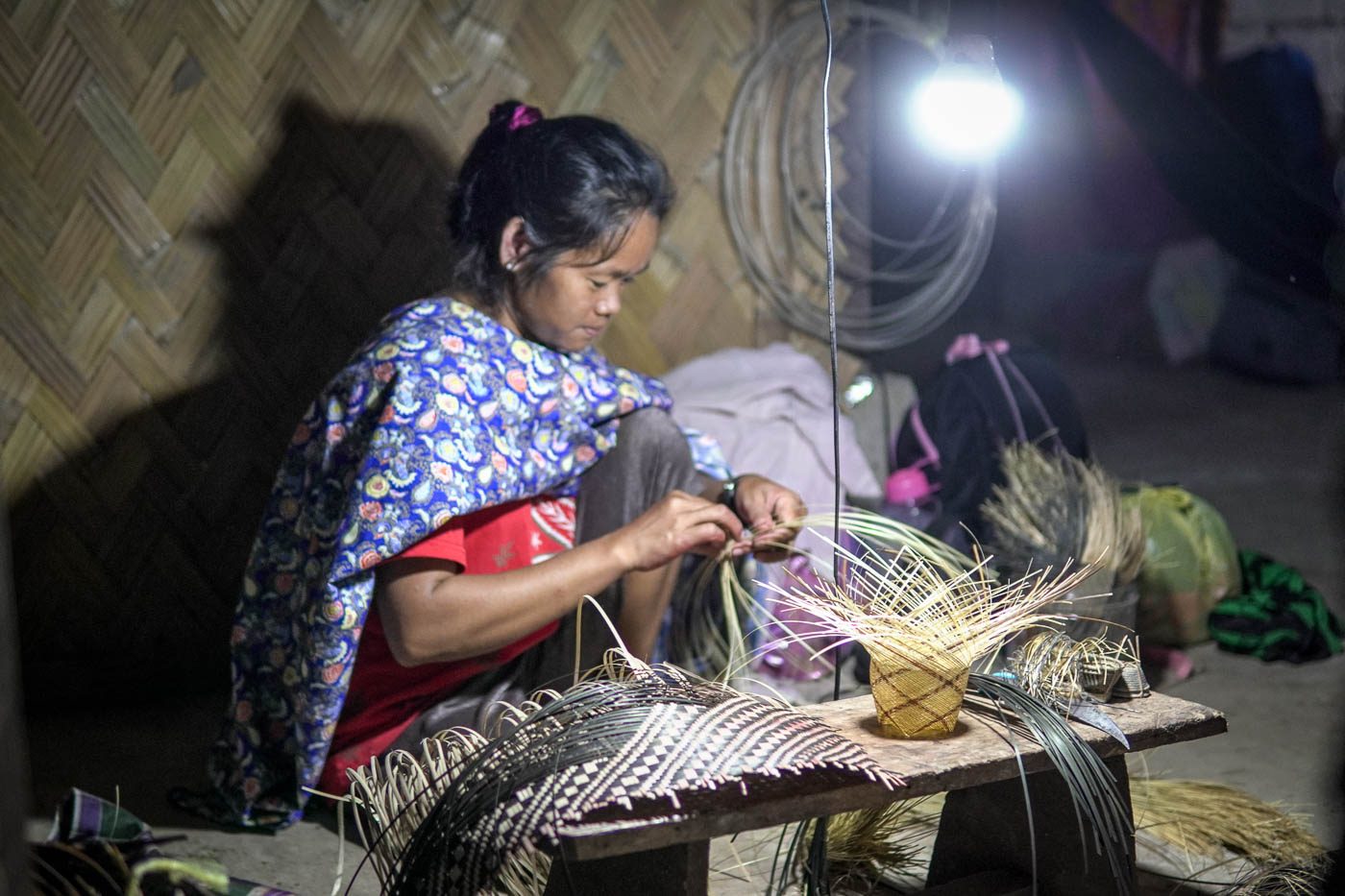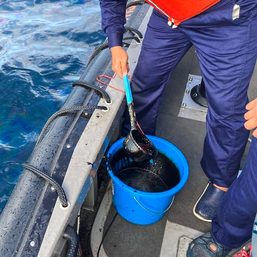SUMMARY
This is AI generated summarization, which may have errors. For context, always refer to the full article.

PALAWAN, Philippines – When the crickets chorus in the mountainous Sitio Kamantian, everything becomes pitch-black except for the solar-powered homes of Pala’wan indigenous women like Marilyn Tiblak.
As the gentle, cold upland breeze wafted through her shack, Tiblak, her husband, and their child huddled under a solar light while munching on boiled sweet potatoes they planted and harvested from their upland farm.
After dinner, the mother, in her 30s, slumped on a bamboo slat floor. A screeching sound filled the room as she began shaving a bamboo pole with a knife. Moments later, her hands carefully wove together fine bamboo strands to make a basket, traditionally called tingkep.
“When we have orders from the lowland, we strive to make baskets at night,” she said in a wispy voice, as she integrated into her craft some forest-inspired designs, like the eye of a bird or the wings of a butterfly.
A basket weaver for half of her life, Tiblak added, “It’s the only time we can focus on weaving without thinking of working on swidden farms and at home, and going into the wild to look for food.”


Perched on southern Palawan’s Mt. Mantalingahan Protected Landscape (MMPL), Kamantian is one of the 37,096 sitios still not reached by the Philippine government’s sitio electrification program, 2021 data showed.
The arrival of solar technologies in Kamantian is a welcome development as it has helped empower traditionally marginalized women like Tiblak to preserve and pass on their basketry tradition, conserve their biodiversity-rich forest, and earn to improve, little by little, the well-being of their families.
Solar power and the basketry tradition
Before, when Kamantian homes were still shrouded in darkness at night, it would take Tiblak a week to finish the intricate weaving of a 12-inch basket that’s sold for P100 in the lowland.
Like many others in her village, she had been igniting resins of wild trees bagtik and saleng so she could weave baskets, which are traditionally used as storage for their upland rice, root crops, vegetables, and other agricultural produce.
With this setup, the already difficult weaving process became even harder for women, because whenever the strong winds blew, especially during the monsoon season, it put out the burning resins, making them lose their momentum.
“We became out of focus whenever that happened because we had to make fire over and over again to continue working,” she said.
The situation got better with the introduction of solar panels and lights in her village, mainly through aid from the government and non-government entities. One such grant that lit up the lives of weaving households was the National Commission for Culture and the Arts’ School of Living Tradition Program (NCCA-SLT).
Approved in 2017, the grant came with the distribution of 15 units of solar panels in Tiblak’s community, where 63 basket weaving masters reside.
“When we visited their community for product development, they told us that they needed solar panels as replacements for lamps they used in weaving at night,” said Maria Margarita Consuelo of nonprofit Non-Timber Forest Product Exchange Programme (NTFP-EP), NCCA’s project implementing partner.
The project came with technical assistance, said Consuelo, NTFP-EP’s enterprise development officer.
“When they received the solar panels, we brought a technician in the community to provide a lecture on the proper use of the technology and the best location where it can be placed to harness its fullest solar energy-harvesting potentials.
“If they experience any problem with the panels, they are advised to inform their tribal leader, so we can provide troubleshooting assistance,” she said.
Each solar panel has a capacity of 12 to 15 watts. Since the small number of panels is not enough to cover all the weaving households, houses are clustered and given one panel each.
“The community identified houses where weavers living around it can gather at night,” added Consuelo, who also serves as the NCCA-SLT provincial coordinator.
Basket production, income doubled
The solar panels have allowed women to weave from 6 pm to 12 midnight, and for some, even up until 3 am. The longer work hours resulted in them doubling the number of baskets they produced each week.
“We used to weave baskets until 10 pm only, and produce two baskets each week. Now with the solar panel, we can weave up to four or five weekly,” said Labin Tiblak, Marilyn’s sister-in-law, who learned the craft from her mother when she was young.
The increase in basket production helped improve household income. Because of this, Labin’s sister and weaver Bingbing Pangan said she’s now able to provide the basic needs of her family.
“Now, my children have slippers. We can buy salt, soy sauce, rice, kitchenware, and even hygiene essentials like shampoo, soap, toothpaste, and toothbrush,” the 41-year-old mother of six said, her face beaming.
Pangan added that they can now also buy clothes to wear whenever they go down to the lowland to sell their root crop produce during market day.
“We’re happy because our nights here are no longer dark,” said Labin’s sister-in-law, 35-year-old Marilyn Monto.
But more than that, Monto said women like her are glad because the income they get from basket weaving helps them provide education for their children. Beyond basket-making, solar lights also help their children do their homeworks at night.
“It’s important for us that our children go to school so they will not be fooled when they deal with people in the lowland,” said the mother of five, who reached elementary education only.


Solar’s compatibility with protected areas
Protected area (PA) management expert Rogelio Andrada II said the use of solar and other renewable energy resources to power communities within protected landscapes in the country is a welcome alternative to fossil fuel-based electrification.
“We know how destructive the fossil fuel-based energy industry can be. From extraction to the byproducts, mostly pollutants, the technology is destructive to not just PAs,” said Andrada, a professor at the University of the Philippines Los Baños
For him, the ecological sensitivity of PAs means they should be “spared” from the development of power plants that rely on coal, diesel, and other fossil fuels.
“If an initiative does not contribute towards conservation of PA resources, then it shouldn’t be done inside or even adjacent to PAs,” he added.
NTFP-EP, meanwhile, believes that the Pala’wan women’s continuous engagement in the basketry livelihood through the use of solar energy can “provide [them] a strong incentive for involvement in forest conservation,” said Consuelo.
The MMPL office agrees that one of the best ways to reduce the threats on forest sustainability is by allowing this tradition to flourish.
“The bottomline is that it gives pressure to the forest if you don’t have alternative livelihoods available for the community,” said PA superintendent Renato Gonzaga. “If their needs are addressed, there would be no one going to the forest to cut down trees, engage in charcoal making, and other illegal activities.”
Gonzaga said indigenous women have special roles to play in the perpetuity of the 120,457-hectare Mantalingahan, which, science says, has an exceptionally high floral and faunal diversity and endemism. The protected area has been in the UNESCO World Heritage Site Tentative List since 2015.
“In community mind-setting, women have a big part,” he emphasized. As they are the ones usually present during outreach activities and aware of environmental policies, he said, “they impart information that guides and molds their husbands, children and the youth” in the community in general to become environmentally conscious as well.
Such active participation by women in protecting Mt. Mantalingahan is vital, as a degraded forest cannot provide climate regulation and flood and erosion control – ecosystem services that can save upland and downstream communities from hazards in southern Palawan identified by the government, such as flash flood and landslide.
Attempt to solarize Palawan’s off-grid areas
Palawan, a designated UNESCO Man and Biosphere Reserve and protected by the Strategic Environmental Plan for Palawan Act, conceived an energy development plan for 2014 to 2035 to resolve its power woes.
The strategic plan ascertains the viability of renewable energy sources – including solar – whose potentials were estimated to be about 13.02 MW. Under this local energy plan – the first of its kind in the country – solar power is integrated into the mix as an energy displacer mainly for diesel.
“There were many investors who reportedly wanted to build solar farms here in Palawan but none have materialized so far,” said engineer Ric Rodriguez, focal person for the provincial government’s energy development program.
In 2015, the Palawan provincial government identified 120,000 isolated households without electrification. To keep the energy plan moving, Rodriguez said they have distributed 53,225 solar home system units to off-grid communities since 2016, around 40 units of which reached Kamantian.
The package includes a 5W to 11W photovoltaic solar panel, a lithium battery, four fixed LED bulbs, a solar lantern, and standard connectors for phone charging, which are replaceable in case of factory defects as long as they’re covered by the two-year warranty period. If they malfunction beyond this timeframe, the technical repair expenses are shouldered by the recipient.
“We prioritize isolated households, especially the indigenous peoples who have no access to electricity,” said Rodriguez.
For environmental lawyer and renewable energy advocate Grizelda Mayo-Anda, efforts like this are laudable, especially “at this time when we are already suffering from the impacts of the climate crisis.”
“Initiatives like this, hopefully, should continue and must be monitored so that whatever the results would be can be lessons to guide other initiatives,” she said.

Lack of budget
The project’s P140-million funding was sourced from Palawan’s share in the Malampaya fund in 2016 and 2018, Rordriguez said.
But when it lost its claim to the gas project earnings, the provincial government tapped its disaster risk reduction management office budget to continue funding the said project, but only up to 2022.
Rodriguez said the continuity of the solar panel distribution project faces uncertainty as there’s no dedicated provincial government budget allocation for electrification.
“Our only problem with this project is the budget,” he said.
Aside from the budget, however, another challenge is the solar home unit systems themselves, which are only a year or two away from their 7-year lifespan. Aware of this limitation, it makes women like Marilyn anxious because it would mean going back to living in the dark, literally and figuratively.
“I worry that soon, our unit will no longer be working. It’s going to affect not only our weaving, but also our children, who also do homework at night,” she said.
Rodriguez admitted that while the provincial government exceeded its initial target of distributing 35,000 units of the solar home system program, it still lags behind in terms of the overall implementation of the energy plan that requires an investment of P53.99 billion. Out of the 120,000 isolated households identified in 2015, only 44.35% have been reached so far by the program.
“The plan was crafted with the assumption that we’re getting our share from Malampaya,” he said. “We are really lagging behind because we don’t have the budget…. If the provincial government can fund the plan implementation, I doubt it, because right now we’re just sharing budget with the infrastructure program.”
Anda, the executive director of the nonprofit Environmental Legal Assistance Center, said there’s a need to review the plan to see how indigenous women’s concerns could fit in, and how this program that benefits them could be sustained.
“We need to revisit the plan to see how we can integrate our IP women concern, making sure that it’s gender-sensitive and gender-responsive,” she said.
Toward a distributed generation system
Although it’s a small-scale effort, the use of solar panels by the Kamantian indigenous basket weavers creates positive momentum toward the decentralization of the country’s power industry, said Jephraim Manansala, chief data scientist of the Institute for Climate and Sustainable Cities.
“For every renewable energy [utilized], no matter how small it is, it offsets oil or diesel, which is towards the right step to lessen our [fossil fuel] dependence,” he said.
According to ELAC, Kamantian can inspire other creative cultural communities to tap into renewables to preserve their traditions while improving their well-being.
“The Pala’wan basket weavers’ use of solar energy should set an example on the use of RE by local communities. If local IP communities can do it, the top consumers of power in Palawan should pursue similar initiatives,” Anda said.
Majority of Palawan’s electricity comes from the Palawan Electric Cooperative (Paleco), supplied by the National Power Corporation-Small Power Utility Group and three independent power producers’ diesel-run generators. Paleco reported that residential customers are its largest market base at 89.76%, followed by commercial customers at 7.65%, industrial customers at 2.45%, and others (i.e., public buildings and streetlights) at 0.14%.
Manansala said solar panels encourage a “prosumers” movement, which enables local communities, especially residential homes, to become both energy producers and consumers.
“The good thing about solar is you don’t need the private sector or big companies to harness it; even the common people, families can do so,” he added.
However, scaling up solar energy utilization is easier said than done in a country where financing community-based renewable energy development in off-grid areas remains limited.
Manansala urged the local government to step up in filling that gap, as he believes that energy accessibility is a human right.
“Off-grid areas are not attractive to big companies…. So we need to enable locals through offering attractive loans for them to have the means to put up solar rooftops.
“If you give them that opportunity, the energy system can become community-based and, through that, we can pave the way for economic development, which will ultimately improve the quality of life in those remote areas,” he added.
More support needed
As the climate crisis heightens the hazard vulnerability of indigenous communities – one of the sectors that contribute the least to this global environmental problem – more government push is needed to mainstream the use of solar and other renewable energy sources in island grids, which a study found to be feasible.
At least in Mt. Mantaligahan, not everyone received solar panels from the government, like 35-year-old Delpin Udle. To light up her home, she had to work with her husband for years before they were able to buy a 20-watt solar panel that cost P2,500.


She weaves baskets, while her husband harvests and sells almaciga resins. Their other income is sourced from making brooms and planting root crops, which they all sell to a lowland market.
“We saved up for three years before we could buy our own unit. It took us that long because we also needed to set aside the majority of earnings for food,” said Udle, a mother of five.
Unlike Udle, Tipin Latapan, who is in her 30s, has yet to buy her own solar panel, so she weaves mostly during daytime. She starts at 7 am and does work until 10 am, before she fetches water and prepares food for her husband and two kids.
“It’s dangerous to do baskets at night, when we only have saleng resin as light. If we don’t pay attention to its fire, it can burn down our home,” said Latapan, as she wove in her house made of deplak or dried leaves of rattan.
Padmapani Perez, an anthropologist and the lead strategist for creative collaboration Agam Agenda, said continuous support for indigenous peoples is crucial as it enables them to have wide and diverse livelihood options, which reflect their wealth of knowledge about environmental sustainability that needs to be transferred from one generation to the next.
All these options, she added, can uphold their right to self-determination and make them feel secure and at peace amid an increasingly hostile climate.
“The projections of climate science point to a future in which life will be much harder for women, children, and the disadvantaged. Providing clean, renewable energy to indigenous women is one of the many things that ought to be done so they can make choices for themselves and expand what’s possible for their people. Indigenous peoples are innovators, after all. They’re adapting ahead of the rest of society,” she said.
As the cold mountain breeze blew, heralding rain, Latapan meticulously wove a tingkep. She will store this in her house atop a mountain until an order for tingkep comes from the town center, which is three hours away by foot.
In a low voice, she said: “I hope that our situation will move our government to extend solar panels here because it’s one way of helping us create baskets even at night, in order for us to pass on this tradition.” – Rappler.com
All quotes have been translated into English.
Reporting for this story was supported by the Institute for Climate and Sustainable Cities under the Jaime Espina Klima Correspondents Fellowship.
Add a comment
How does this make you feel?



![[ANALYSIS] Why do we pay higher power rates when we have power outages?](https://www.rappler.com/tachyon/2024/07/tl-higher-power-rates-higher-power-outages.jpg?resize=257%2C257&crop=401px%2C0px%2C1080px%2C1080px)














There are no comments yet. Add your comment to start the conversation.